
The Okeechobean Sea was a Cenozoic eutropical subsea, which along with the Choctaw Sea, occupied the eastern Gulf of Mexico basin system bounding Florida.

The Okeechobean Sea was a Cenozoic eutropical subsea, which along with the Choctaw Sea, occupied the eastern Gulf of Mexico basin system bounding Florida.
The Okeechobean Sea was named for Lake Okeechobee of southern Early Oligocene Florida. It occupied southern Florida from what is now Tampa, Florida, to the Kissimmee River and to Martin County on the east and southward across the Everglades to the tip of Florida. The Okeechobean (including its subseas) survived until the Pleistocene making it the longest-lived paleosea in eastern North America.

The Okeechobean Sea was divided further into two groups of a combined 10 subseas based upon marine fauna. These subseas were named:
The Dade Subsea was named for Dade County, Florida fossil reefs and is contemporary with the Bainbridge Subsea of North Florida. It is the last platform created from carbonate deposits and the predecessor of the recent Florida peninsula. It was formed out of the meteor impacts and tsunamis of the colder Eocene. By the mid Rupelian, the global climate warms and Florida consists of just Orange Island, a somewhat long island with coral reefs extending as far north as Alabama and Georgia forming the Salt Mountain formation and Flint River Formation respectively. Along its west coast lay the Pasco Reef System. separated from the mainland by the Gulf Trough or Suwannee Strait also with coral reefs. Orange Island lay just 150 km (93 mi) from Georgia. Two deep carbonate features will eventually become the substructure of the Everglades.
Basilosaurus cetoides and Zygorhiza , early toothed whales, as well as Protosiren , an extinct ancestor of the manatee, inhabit these waters and are the earliest mammal fossils uncovered with specimens from Citrus County in dolomite dating to ~40—37 Ma. and Marion County, Florida dating from 37.2—33.9 Ma. [1] [2]

The Tampa Subsea was named for the Tampa, Florida and reef system. It is contemporary with the Chattahoochee Subsea in the Florida Panhandle. During this period, Orange Island grew in size toward the west and north while the Gulf Trough or Suwannee Strait narrowed and became shallower. On Orange Island's western side, upwelling systems were taking place with a system of lagoons and coral islands not unlike the Florida Keys evolving. In what would become the Everglades, the carbonate banks grew and the area became shallower.
The Gulf Trough closed between Georgia and Florida forming the complete peninsula allowing southward movement of Florida's first land mammals such as the early canids Enhydrocyon , Osbornodon , and Phlaocyon preying upon the proto-horse Miohippus , deer-like Hypertragulidae , and the extinct camel, Nothokemas . The fossil record shows that land animals entered the newly formed peninsula with the earliest land mammals unearthed in Hernando, County dating from ~24.8 Ma. [3]
The Arcadia Subsea was named after the Arcadia Formation [4] and is contemporary with the Chipola Subsea to the north in the panhandle. During this period, the Florida peninsula forms as the Gulf Trough closes in the north and fills with mangrove forests. South of what was Orange Island and is now the peninsula's tip, was a deep water lagoon with many banks made of oyster bars and coral reefs. The largest bank was located on its southwest. Also by this time, phytoplankton blooms along the western coast poured into the Arcadia Subsea. [5] The Middle Miocene Climatic Optimum of ~16 Ma. [6] carbon dioxide and a climate change increases, warming the planet. The Middle Miocene disruption, an extinction of many mammal genera begins.
The Arcadia begins to regress with a very short dry period lasting possibly 1 million years. During this time the Middle Miocene Disruption continues. Forests slowly draw in massive amounts of carbon dioxide, gradually lowering the level of atmospheric CO2 to approximately 100 ppmv.
Metaxytherium floridanum a form of manatee, and long beaked dolphin (Pomatodelphis) swam this subsea. The fossil of Mesoplodon longirostris is found on the Miami Terrace dating to ~15.97—11.61 Ma. [7]

The Polk Subsea was named for the rich fossil beds of Polk County, Florida and contemporary with the Walton Subsea. During this rather short period of time of 400,000 years, the peninsula's southwestern edge develops a shallow yet broad lagoon system. Near western DeSoto County, erosion creates water-filled sinkholes and rivers with sediments from this erosion enhancing the carbonate bank on the southwest and producing large oyster bioherms along the seaward side of the lagoon system as well as banks to the south. The upwelling of nutrients and phytoplankton of the Arcadia Subsea continued and increased eventually flooding the lagoon system and Okeechobee Basin and contributing to the building of the Peace River Formation.
Sperm whale (Kogiopsis floridana), 9.1—9.0 Ma. Fossil specimen found in the Amalgamated Phosphate Mine; Brewster Phosphate Mine, Polk County, Florida. [8]
The Charlotte Subsea was named for the fossil beds found in Charlotte County, Florida. A rather short-lived subsea, during this period the rivers and lakes of the DeSoto Plain are complete and produce vast quantities of sediment deposited in the Okeechobee Basin. The banks on the western side of the Charlotte Subsea force material southward producing the DeSoto Delta. This delta filled in approximately 50% of the western Okeechobee Basin producing a platform.
Fossils of the beaked whale, river dolphin, and a form of toothed whale (Kentriodontidae) dating to ~7.9—7.8 Ma. are uncovered in Polk County. [10]

The Murdock Subsea was named after Murdock Station Formation [11] and followed the worldwide cooling and sea level lowering of the Messinian stage. This period is the last one of delta creation upwelling and one of fast erosion in Florida with sediments quite rapidly flowing into the Everglades area creating what is known as the Immokolee Delta. The Okeechobean flooded again creating the Murdock Subsea and covering the Immokolee Delta which disbursed its sediments further south into the glades. What remained was a long deep water feature on the eastern side of the Murdock. Upwelling with plankton blooms continued along the west coast supporting well as oysters and similar animals.
Balaenoptera floridana and Delphinidae were found in Lee County. [12] and Bone Valley Formation.
The Tamiami Subsea is named after the Tamiami Formation. This period is marked by a warming climate and one in which produced tropical conditions in Florida. Upwelling of cooler, nutrient rich water halted and the Okeechobee Basin returned to evolving through carbonate sedimentation with both Immokolee and DeSoto deltas now were covered and looking similar to the Bahama Banks.
During the Tamiami Subsea's creation, the basin of the Everglades was encompassed by the Everglades Pseudoatoll. This feature's north side supported mangrove jungles and estuaries extending to the mainland and Kissimmee Embayment. The east, west, and south were created by reefs and islands of over 100 species of coral which grew atop the Hawthornian oyster and barnacle bars. The Nashua Lagoon System extends along the entire east coast of Florida.
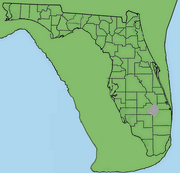
The Caloosahatchee Subsea was named for the Caloosahatchee Formation. During this period, the Tamiami Psedoatoll feature of islands and reefs became wider and the marine environment was shallower and more of a connected lagoon system. The west and south of the Okeechobean was covered with mangrove.
During the late Calabrian, ~1.8 Ma.—780,000 years ago, temperatures plunged to that or possibly colder than the Messinian-Zanclean [13] with the Caloosahatchee basin rising and filling with rock and mineral deposits. All of the paleoseas experienced mass extinction of endemic species.
The Loxahatchee Subsea was named after the Loxahatchee Formation. The Pre-Illinoian began as a general warming from the frigid late Calabrian stage yet contained several ice ages and interglacials of its own. During one of several Pre-Illinoian glaciations, the Loxahatchee Subsea then consisted of a freshwater lake called Lake Immokolee filled with calcarenite charaphytes and siliclastic material from what would eventually be the Kissimmee River. It was approximately four times the size of Lake Okeechobee and existed until the next interglacial.
The Okeechobean Sea experienced the last deposits of sediments allowing the Loxahatchee Subsea as well as the Kissimmee Valley and Okeechobee Plain to fill and become 50% covered with mangrove forests. This new Loxahatchee Subsea was filled with mangrove islands. The mangrove islands of southwest Florida are reduced to coastal swamps. On the eastern side of the new Loxahatchee Subsea, reefs became wide islands covered with pines and palmettos with deep water surrounding them. A lagoon was created on the east with warmer water than surrounding water creating a refuge for corals and mollusks which became extinct along the eastern U.S. coastline.
In the west, Immokolee Island had been created from banks and reefs. To the east lay Miccosukee Island south of where Lake Okeechobee is currently. The Tomeu Islands were near future western Palm Beach County All three islands were covered with pine and palmetto forests. Flanking the Tomeu Islands on the west was the Capeletti Reef Tract. The southeastern and Atlantic facing part of the peninsula supported the Miami and Palm Beach Archipelagos. Connected and to the south of that and what would be the future Florida Keys was the Monroe Reef Tract.
The Belle Glade Subsea was named after Belle Glade, Florida and lasted ~300,000 to 75,000 years ago, a period of ~ 0.225 million years. During this time the Okeechobean Sea locality was much shallower than previous. Geologic features were greatly enlarged compared with the aforementioned Loxahatchee Subsea. Islands and mangrove forests filled 75% of the Okeechobean basin.
The Lake Worth Subsea was named for Lake Worth Formation and lasted from ~300,000—75,000 years ago, a period of 0.225 million years. The eastern lagoon of Okeechobean Sea had filled in with sands, quartz, and carbonates. A series of keys extended along the continental shelf to almost Key West. Oolite was created behind reef sections from pounding seas originating off of Africa due to a submerged Bahamas Bank.
The Lake Worth Subsea was the last flooding stage of this area. It regressed during the Wisconsin Ice Age and infilled to become a shallow basin creating the Everglades.
The Miocene is the first geological epoch of the Neogene Period and extends from about 23.03 to 5.333 million years ago (Ma). The Miocene was named by Scottish geologist Charles Lyell; the name comes from the Greek words μείων and καινός and means "less recent" because it has 18% fewer modern marine invertebrates than the Pliocene has. The Miocene is preceded by the Oligocene and is followed by the Pliocene.

The Neogene is a geologic period and system that spans 20.45 million years from the end of the Paleogene Period 23.03 million years ago (Mya) to the beginning of the present Quaternary Period 2.58 million years ago. The Neogene is sub-divided into two epochs, the earlier Miocene and the later Pliocene. Some geologists assert that the Neogene cannot be clearly delineated from the modern geological period, the Quaternary. The term "Neogene" was coined in 1853 by the Austrian palaeontologist Moritz Hörnes (1815–1868). The earlier term Tertiary Period was used to define the span of time now covered by Paleogene and Neogene and, despite no longer being recognized as a formal stratigraphic term, "Tertiary" still sometimes remains in informal use.
The Pliocene is the epoch in the geologic time scale that extends from 5.333 million to 2.58 million years ago. It is the second and most recent epoch of the Neogene Period in the Cenozoic Era. The Pliocene follows the Miocene Epoch and is followed by the Pleistocene Epoch. Prior to the 2009 revision of the geologic time scale, which placed the four most recent major glaciations entirely within the Pleistocene, the Pliocene also included the Gelasian Stage, which lasted from 2.588 to 1.806 million years ago, and is now included in the Pleistocene.
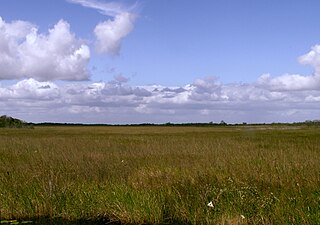
The Everglades is a natural region of flooded grasslands in the southern portion of the U.S. state of Florida, comprising the southern half of a large drainage basin within the Neotropical realm. The system begins near Orlando with the Kissimmee River, which discharges into the vast but shallow Lake Okeechobee. Water leaving the lake in the wet season forms a slow-moving river 60 miles (97 km) wide and over 100 miles (160 km) long, flowing southward across a limestone shelf to Florida Bay at the southern end of the state. The Everglades experiences a wide range of weather patterns, from frequent flooding in the wet season to drought in the dry season. Throughout the 20th century, the Everglades suffered significant loss of habitat and environmental degradation.

Everglades National Park is an American national park that protects the southern twenty percent of the original Everglades in Florida. The park is the largest tropical wilderness in the United States and the largest wilderness of any kind east of the Mississippi River. An average of one million people visit the park each year. Everglades is the third-largest national park in the contiguous United States after Death Valley and Yellowstone. UNESCO declared the Everglades & Dry Tortugas Biosphere Reserve in 1976 and listed the park as a World Heritage Site in 1979, and the Ramsar Convention included the park on its list of Wetlands of International Importance in 1987. Everglades is one of only three locations in the world to appear on all three lists.
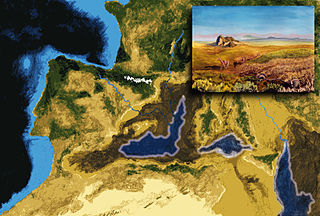
The Messinian salinity crisis was a geological event during which the Mediterranean Sea went into a cycle of partial or nearly complete desiccation (drying-up) throughout the latter part of the Messinian age of the Miocene epoch, from 5.96 to 5.33 Ma. It ended with the Zanclean flood, when the Atlantic reclaimed the basin.

The Zanclean is the lowest stage or earliest age on the geologic time scale of the Pliocene. It spans the time between 5.332 ± 0.005 Ma and 3.6 ± 0.005 Ma. It is preceded by the Messinian Age of the Miocene Epoch, and followed by the Piacenzian Age.
The Piacenzian is in the international geologic time scale the upper stage or latest age of the Pliocene. It spans the time between 3.6 ± 0.005 Ma and 2.588 ± 0.005 Ma. The Piacenzian is after the Zanclean and is followed by the Gelasian.

In biogeography, the Mediterranean Basin, also known as the Mediterranean Region or sometimes Mediterranea, is the region of lands around the Mediterranean Sea that have mostly a Mediterranean climate, with mild to cool, rainy winters and warm to hot, dry summers, which supports characteristic Mediterranean forests, woodlands, and scrub vegetation. It was a very important part of Mediterranean civilizations.
The Messinian is in the geologic timescale the last age or uppermost stage of the Miocene. It spans the time between 7.246 ± 0.005 Ma and 5.333 ± 0.005 Ma. It follows the Tortonian and is followed by the Zanclean, the first age of the Pliocene.
Calabrian is a subdivision of the Pleistocene Epoch of the geologic time scale, defined as 1.8 Ma—774,000 years ago ± 5,000 years, a period of ~1.026 million years.
The indigenous people of the Everglades region arrived in the Florida peninsula of what is now the United States approximately 14,000 to 15,000 years ago, probably following large game. The Paleo-Indians found an arid landscape that supported plants and animals adapted to prairie and xeric scrub conditions. Large animals became extinct in Florida around 11,000 years ago. Climate changes 6,500 years ago brought a wetter landscape. The Paleo-Indians slowly adapted to the new conditions. Archaeologists call the cultures that resulted from the adaptations Archaic peoples. They were better suited for environmental changes than their ancestors, and created many tools with the resources they had. Approximately 5,000 years ago, the climate shifted again to cause the regular flooding from Lake Okeechobee that gave rise to the Everglades ecosystems.

Before drainage, the Everglades, a region of tropical wetlands in southern Florida, were an interwoven mesh of marshes and prairies covering 4,000 square miles (10,000 km2). The Everglades is both a vast watershed that has historically extended from Lake Okeechobee 100 miles (160 km) south to Florida Bay, and many interconnected ecosystems within a geographic boundary. It is such a unique meeting of water, land, and climate that the use of either singular or plural to refer to the Everglades is appropriate. When Marjory Stoneman Douglas wrote her definitive description of the region in 1947, she used the metaphor "River of Grass" to explain the blending of water and plant life.
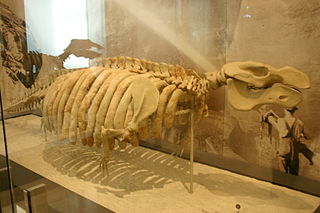
Metaxytherium is an extinct genus of dugong that lived from the Oligocene until the end of the Pliocene. Fossil remains have been found in Africa, Europe, North America and South America. Generally marine seagrass specialists, they inhabited the warm and shallow waters of the Paratethys, Mediterranean, Caribbean Sea and Pacific coastline. American species of Metaxytherium are considered to be ancestral to the North Pacific family Hydrodamalinae, which includes the giant Steller's Sea Cow.

The Choctaw Sea was a Cenozoic eutropical subsea, which along with the Okeechobean Sea, occupied the eastern Gulf of Mexico basin system bounding Florida.
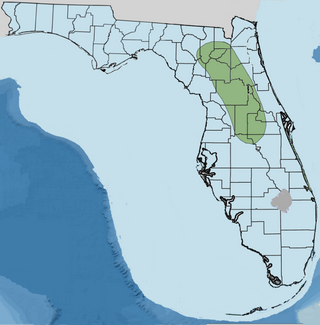
Orange Island is the earliest emergent landmass of Florida dating from the middle Rupelian ~33.9—28.4 Ma. geologic stage of the Early Oligocene epoch and named for Orange County, Florida, United States of America.
The Everglades Pseudoatoll was a major geomorphic feature of southern Florida during the Pliocene epoch.
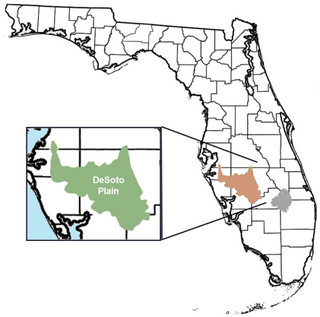
The DeSoto Plain is a major geologic feature of Florida formed during the Miocene epoch and named for DeSoto County, Florida, United States.
The Okeechobee Group is a geologic group in Florida. The group preserves fossils dating back to the Neogene period. This group of formations in the Everglades were deposited when high tropical water started to return in the Late Zanclean Period.

The Zanclean flood or Zanclean deluge is a flood theorized to have refilled the Mediterranean Sea 5.33 million years ago. This flooding ended the Messinian salinity crisis and reconnected the Mediterranean Sea to the Atlantic Ocean, although it is possible that even before the flood there were partial connections to the Atlantic Ocean. The reconnection marks the beginning of the Zanclean age.